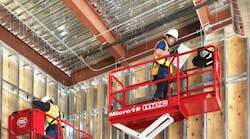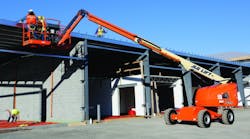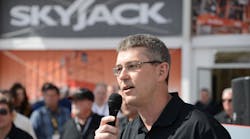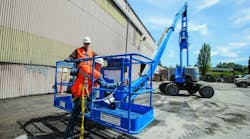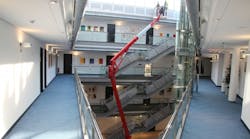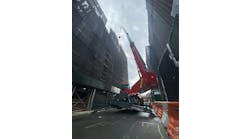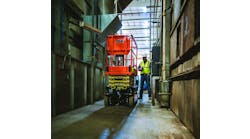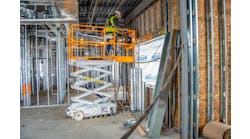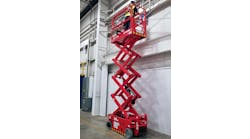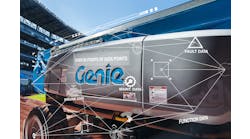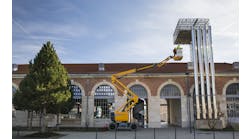Interviews with Aerial Manufacturers: Bigger Jobs in Less Time
Aerial manufacturers talk about the dramatic advancements in technology, safety enhancements, the effects of tariffs and more.
Participants:
Brad Boehler, president, Skyjack;
Paul Jensen, Marketing Communications & Customer Analysis Manager, AMERICAS
Matt Fearon, Genie President, Terex AWP
Janne Pulkkinen, vice president North America; Johanna Kulmala, marketing manager, and Alan Hoffman, sales manager, Bronto Skylift;
Jennifer Stiansen, director of marketing, JLG Industries;
Justin Kissinger, vice president of marketing, Hy-Brid Lifts by Custom Equipment;
Gary Crook, vice president of engineering, MEC Aerial Work Platforms
RER: What are some of the new developments technologically in your company’s equipment during the past year?
Boehler: The standout development was the launch of Elevate – our Telematics package. We planned to launch at The Rental Show in New Orleans, but news of what we were up to leaked out and we ended up launching with commitments of 7,000 units for delivery in 2018 before we really started promoting. We were so successful because we had spent a lot of time talking to customers and, in reality, had to re-invent telematics for the rental industry, rather than trying to force a typical (on- road based) model on to off-highway machines. So, not the most information but the most important information -- a mobile-first philosophy for a very mobile industry, tailored and optimised to provide features unique to Skyjack equipment...all at a price that made sense for a 19-foot scissor lift to a 12,00-pound telehandler.
Jensen: Haulotte made a big splash at Intermat in April unveiling our HA61 LE and HA61 LE PRO electric-architecture machine. Haulotte is leading the industry with the first 100-percent electric-architecture rough-terrain boom and a 5-year warranty as well as a commitment to convert the entire MEWP offering to electric architecture.
Haulotte also unveiled two new mobile apps. Haulotte Diag creates a link between your phone or tablet and a wifi-enabled machine for access to diagnostics and programming in the palm of your hand.
The Quick Positioning app guides users through the process of selecting the right equipment for the job. The user takes a picture of the area that needs to be accessed and through a series of guided steps is given a recommended machine that will have the correct reach and up-and-over height to access the area. This innovative app will help get the right machine to the jobsite the first time while increasing productivity and safety.
Fearon: From a machine standpoint, Genie continues to be heavily invested in maximizing the value and rental return on invested capital (rROIC) of our products. Even as global standards are changing how operators do work, we are looking at ways of increasing their productivity. The new Genie Xtra Capacity (XC) booms are designed to provide exceptional capacity consistently across a wide range of products. When customers see the “XC” nomenclature on a Genie machine, they will know that they are getting 660-pound capacity over the maximum range of motion, and 1,000-pound maximum capacity to tackle even the heaviest jobs in less time. The “XC” stamp also signifies that these machines meet the overload requirements of the new ANSI and CSA standards for North America, as well as the EN280 standards in Europe and the AS 1418.10 standards in Australia.
Genie also continues to invest in additional products related to the changing requirements of our global customers and how end-users do work safely and productively. Over the last few years, the industry demand for secondary guarding solutions has accelerated, motivating the standardization of secondary guarding on boom lifts. Genie is committed to supporting efforts to improve workplace safety and productivity on all aerial products, and at its core, the Genie Lift Guard Contact Alarm prototype for scissors was driven by customer feedback and demand from global markets for a secondary guarding solution for scissor lifts and vertical lifts.
The Genie Lift Guard Contact Alarm for scissor lifts and vertical lifts is a switch-based solution that uses activation whiskers mounted on the platform guardrails to sense obstructions. When an activation whisker makes contact with an obstruction, such as a pipe, beam or doorsill, machine motion is stopped. Operators can center the joystick and release the function enable momentarily, which will enable them to then continue to position the platform at reduced function speeds.
Unique to the Genie Lift Guard Contact Alarm system is its visibility to operators, occupants, and ground personnel, providing unmatched clarity regarding the sensing zone. The Genie Lift Guard Contact Alarm tool will supplement a trained operator’s situational awareness and allow operators to make better decisions about how and where they position the platform, without the nuisance trips associated with ambiguous sensing envelopes.
Pulkkinen: Bronto Skylift continues to be on the cutting edge of utilizing new technology and IOT. Our Skylift Fleet management system allows fleet owners to track all functions during the work day. It allows the owner to schedule and predict maintenance based on actual usage instead of calendar days or hours. It is customizable to allow the end user to track items of interest important to them. Bronto Compass system allows for remote communications with the Bronto Skylift aerial to troubleshoot operational issues and correct many without the need to dispatch technicians. Trouble can be pinpointed and appropriate repair parts can be dispatched quickly to get the equipment operational in the shortest amount of time. In Europe we have also launched a new 35-meter work machine to answer the demand for a quick, easy and compact rental unit for inner cities.
Stiansen: We have implemented new technologies into our electric scissors, many of which are exclusive to JLG. We have two distinct lines for customers to choose from: The ES Series, with premium features including an efficient electric-drive system, and our value-driven hydraulic drive R Series, with a simplified active pothole protection system. In some instances, such as lubrication-free scissor arm bushings, the lines share common technologies to deliver maximum uptime.
Our exclusive variable tilt technology, included on both ES and R Series scissors, allows operators to elevate to limited heights when working on slight slopes, maximizing the work envelope.
Additional technologies included on JLG scissor lifts include:
- Controlled elevation descent, which cushions the ride for the operator when the scissor is coming to a stop on the way up or just before it reaches the bottom on the way down. This technology is included on both ES and R Series models.
- Controlled drive descent, included on both ES and R Series models, allows for smooth descents and protects machine components as customers traverse steep slopes.
- The 4045R, the narrowest machine in its size class, offers zero load calibration. Its pressure-based load sensing system (LSS) includes functionality for a simple calibration that can be performed in the field without calibrated weights. As a bonus, the JLG LSS is less sensitive to ambient temperatures, especially in cold-weather applications.
- Dual capacity is available on select ES Series models, providing customers and end users with the ability to take additional materials and tools to lower elevations up to the restricted capacity of the unit.
Crook: Just over a year ago MEC introduced its new direct electric-drive slab scissor line to provide extended duty cycles and faster drive speeds while virtually eliminating hydraulic leaks. In the past year we further expanded our line to include the Micro 19 scissor lift. Together the 1330SE and Micro 19 strengthen MEC’s offering in micro scissor lifts as an alternative to vertical masts and traditional scissor lifts due to its micro footprint for easy accessibility in tight spaces and spacious platform to support 2 workers.
MEC also introduced the 45-AJ, a 45ft articulated boom lift. With a 48-HP diesel Kubota engine, the 45-AJ is the only machine in its class to offer 360-degree continuous rotation. Fully featured with solid rough terrain tires, 6-foot-wide, 3-sided entry platform with swing gate, powerful 4WD and oscillating front axle are a few standard features. This product demonstrates our value for full-featured, rugged, simple and reliable boom lifts.
RER: What trends do you see on the horizon with your company’s equipment, and the industry as a whole?
Jensen: The big trends we see involve electric-powered products and telematics. These technologies are becoming more common within most of the construction equipment industry, not just the MEWP industry. Haulotte is leading both trends with the new “Blue” strategy that was announced during our Intermat press conference. Haulotte is committed to removing internal combustion engines from the entire MEWP range. The blue strategy is also a commitment to partnering closely with our customers as a solution provider. We see the potential of the data gathered and analyzed from telematics as just one of the ways we can add value for our customers. We will be able to use statistics to predict upcoming maintenance requirements, reducing downtime and saving money at the same time.
Fearon: As we continue to work with our customers on helping them realize the highest rROIC on their machine purchases, we are finding that maximizing their utilization is key. Providing insights into how a machine is utilized and what may keep it from working are instrumental in planning and operating their businesses. Telematics solutions that include information about how a machine is working, as well as what maintenance may keep it from having to come off a job, are a great way to capture and manage this critical data. We are continuing to work directly with our customers to make sure that they have the access to as much of this information as possible, including a link to our machines via a CAN-based control system, as well as what offerings may make them even more efficient in the future.
As our customers continue to become more technologically savvy, we are seeing a growing trend in the use of technology for fleet management. Telematics is a tool that many are starting to use to manage their equipment fleets, from basic location tracking to more sophisticated equipment monitoring. From knowing how equipment is performing or how often a piece is being utilized to where each unit is or when it is ready for maintenance, machine data can provide a lot of insight to a rental business. Today’s technology can help our customers gather, read and understand the information their machines are providing.
In my opinion, we are in the early stages of the adoption of telematics, mobile applications and data-driven fleet management. I expect rental companies around the world to increase their use of these capabilities in the coming years to drive higher rROIC.
There are a few trends that we are seeing that are related to some of the development work we have been doing over the last few years. As emissions standards around the world have become more stringent, engine manufactures are forced to provide solutions that are more costly and complex. To mitigate this, Genie has developed an innovative fuel-electric system for the Genie Z-60/37 FE articulated boom that gives performance of a typical diesel-powered boom in a hybrid machine.
Pulkkinen: The high reach aerial market continues to grow taller and taller. The wind sector is asking for more and more equipment above the 100-meter working height. Electric transmission lines continue to increase in height for both insulated and non-insulated products. At the same time there is a growing need for quick and compact platforms for inner city maintenance and repair work especially in Europe, but in U.S. too.
Stiansen: Most recently, we added a BIM (building information modeling) library to our website. We know that BIM is transforming the architecture, engineering and construction industries, so we felt it was an important addition to the website to encourage communication and collaboration for our customers. All models in the library are available to download in a data-rich format. The main benefit of JLG BIM models is their ability to give design-build contractors and architects the opportunity to anticipate jobsite challenges they may face before breaking ground, allowing them to manage risk and eliminate guesswork on the front end of project planning. For rental companies, a major advantage of BIM is that very early on during a project, they can identify the equipment that will be required on the jobsite and plan for transportation before it’s needed. This will ensure that the right product is delivered on time to complete the work at hand.
Another trend or issue for the industry is attracting a new generation of construction workers. There’s been a lot of discussion around the aging workforce and a gap in skilled workers for all levels of the business. A job in the construction industry offers many benefits, and we want to do as much as we can to attract and retain new talent.
Kissinger: It’s our goal to make lifts that help contractors do their jobs safely and efficiently and we foresee those topics continuing to become growing concerns in the industry. While we feel we do a great job of checking those boxes with features such as low step-in heights, high-capacity platforms and compact maneuverable designs, we’re continually looking for opportunities to better serve customers. Most recently this has been in the form of tool trays and pipe racks that allow installers to load the lift with as much as 200 pounds of material, minimizing the number of trips up and down to load the lift.
We’re also excited to see more contractors taking a ladders-last approach and using our lifts to help their crews safely perform work typically done with ladders. One of the most recent projects was the construction of UP Health Systems’ new hospital in Marquette, Michigan. HJ Martin and Son, the contractor installing the framing and drywall for the hospital, is using 30 of our low-level lifts to install what will be 2,552,315 square feet of drywall when the project is wrapped up this fall. The contractor noted that in addition to providing a safer alternative to ladders, they also appreciated the low 20-inch step-in height and zero-turn radius of the units. We anticipate more contractors will take a similar approach to fall safety and incorporate a ladders-last initiative.
Crook: There has been increased interest in electric-drive rough terrain models. MEC offers a variety of electric-drive rough-terrain scissor lifts such as the 4069ERT and 26-foot and 30-foot speed levels, in addition to a 60-J electric-drive boom lift with a hybrid option. These machines are ideal for both indoor and rough terrain applications. Our electric-drive engines are quiet compared to diesel options which allows construction work in areas with noise-abatement regulations.
Boehler: I would start with Elevate. Our approach has led to much thought on predictive maintenance, true battery management techniques, better understanding of user applications and other value-added benefits. We are also actively looking at new power sources for our machines, so configurations like electric drive, hybrids and other environmental or efficiency gains are under intense study. While some of these are not the cutting edge of technology in general, as a company focused on the rental industry we have always looked to take any technology and mold it into pragmatic solutions for those customers, both in terms of performance and cost. As a final point, I am on record of challenging my team to bring functional autonomous machines to market by 2023 and we have a roadmap within our Innovation team to accomplish this task.
RER: The price of materials is rising with the recent implementation of tariffs from the Trump administration and by other countries in response. How big an impact will this have on manufacturing and on demand for aerial equipment in the marketplace?
Fearon: The recent actions by the Trump administration on tariffs and concerns over trade wars, have had a dampening effect on the growing optimism that the tax changes had created. There was an immediate reaction by U.S. steel mills that significantly raised domestic steel prices. This led to increase costs which have unfortunately been passed on as a steel surcharge.
Certainly, the tax changes have helped offset some of the impact. U.S. companies having a lower tax rate means they’re going to have more money to invest. Rental companies, especially those in acquisition mode, are going to look at whether they can expense their machines rather than depreciate them over a long period of time, and we’re going to see a lot of them saying “hey, this is a unique opportunity.” I don’t think it’s going to radically change what people are doing, but it’s certainly not hurting the overall sentiment.
We can also see the positive effects that talk of infrastructure spending is having. There hasn’t been a huge infusion of money yet, but it seems like every airport I go to is putting up a terminal. There’s no clarity on where the money is coming from, but there are a lot of people saying it looks like it’s going to happen.
All in all, customers are upbeat. They’re getting busier and healthier. And they’re seeing the growth broaden out, so people are feeling good, that’s for sure. The market is strong. This time last year, we were starting to see all the signs, and now they’re clearer. If you look at rental fundamentals -- time utilization and rental rates have come up, the used equipment market is healthy -- those are the core things we’re looking at. Our backlog at the end of December was the highest year-end backlog in Genie’s history, and now 2018 just keeps getting stronger. What’s interesting is that backlog is all over the world too, not just any one market. Certainly, North America drives a lot of it, but Europe is very strong, and Asia is strong.
Right now, we’re still seeing evidence that the replacement cycle will continue to come into our favor in 2018-19. That’s happening, it’s real. So, we’ve got that underlying demand that’s going to be driven just by replacement alone. We need to watch out and always be careful, but when this market runs you’ve got to be able to meet demand. We’ve built our manufacturing system and supply chains to be able to handle the upticks in the market.
We’re optimistic about the next couple of years. We’re not without caution, and from a manufacturer’s standpoint, the issues around tariff and trade are going to have a big impact on steel. The labor shortage, across the board, is also a concern. There aren’t enough truckers to move the equipment around, the supply chain is getting pinched. As everything comes up, there are going to be hurdles, but I view these as the good problems. There’s hard work to do to keep up with the growth, but it’s nothing we’re not used to.
Pulkkinen: I do not see any of the political implications affecting Bronto Skylift at this time. The economy as a whole has been showing steady growth the last couple of years, which is generally the case with a new presidency.
Stiansen: We are experiencing an impact not only directly due to tariffs but also indirectly through increased domestic steel prices that developed as tariffs were being discussed. However, the construction and rental industries remain very strong, which is a strong signal for the continued health of the access segment.
Crook: The tariff is causing increasing price pressure on raw materials and component parts. If rental rates remain flat, rental companies will continue looking for the lowest cost at the highest value as manufacturers are forced to pass on some increase in price.
Boehler: Our industry is being impacted on a variety of fronts related to trade. Material costs are rising and to be blunt, they are rising sharply, to the point where they can no longer be contained within the current OEM cost structure. Rental companies will be negatively affected. At Skyjack we have contained price pressures to date and not taken immediate, “knee jerk” reactions. I tend to think others should have done so as well. Announcing pricing increases and steel surcharges, before the tariff were enacted casts all OEMs in a bad light of being opportunistic and greedy. However, with the supporting facts coming forward, I see a time in the near future where an appropriate pricing response from Skyjack is rational and necessary.
As far as tariffs are concerned, I am a firm believer in globalization and that the way to “protect” an industry is to encourage it to help itself to become productive, efficient and effective. Artificial methods such as tariffs really just cement the status quo and incent poor commercial behaviour within the industry you wish to protect.
Looking at it another way, the U.S. has announced the intent for a substantial infrastructure bill. It is likely that there is not enough construction equipment to support the bill’s aspirations...yet tariffs have at best added a significant cost increase to both the machinery and the project materials, jeopardizing the outcome of the legislation completely.
Ultimately, coming back to the question, both material cost and tariffs will certainly have an impact on rental companies.
Jensen: Haulotte is in an interesting position with the tariffs. As a French-based company with manufacturing locations around the world, we haven’t seen an immediate effect on the machines we import in to the U.S. for sale. But we also proudly manufacture an increasing number of machines in the U.S. that will likely see an impact as suppliers are forced to raise prices of their finished goods.
As an industry, we may see a decreased demand for new MEWPs if tariffs increase material prices enough to put downward pressure on construction starts. At the same time, we are currently at the top of an industry purchasing cycle that is predicted to begin to naturally shrink within the next year. This timing may work in the favor of the MEWP industry compared to the previous 2007 downturn.
RER: Safety continues to be an important topic in the aerial industry. What are some of the new safety developments on your company’s equipment and do you see any new developments on the horizon?
Pulkkinen: Being a global manufacturer, we see the most current requirements being incorporated on an ongoing basis. Our platforms are full of safety features and we value safety above everything else in our product development. The Bronto+ control system in our platforms takes care of stability and outreach calculations and training of safe working methods is always an integral part of purchasing a Bronto platform. For us safety is a way of working from product development to after sales and maintenance, not any sole innovation or development.
Stiansen: We continually talk to our customers and their customers to gain valuable insights into their constantly evolving equipment needs. JLG product developments are then prioritized to ensure we invest our research and development dollars in the technologies and product enhancements that will deliver the most value to owners and operators.
Safety remains of utmost importance to our company. As such, we have a number of technologies offered as standard equipment on our machines. We have our exclusive SkyGuard enhanced control panel protection system on all JLG boom lifts. Developed after extensive research and testing, the SkyGuard sensor, when activated by approximately 50 pounds (23 kg) of force, stops all functions in use at the time. After stopping the machine, it temporarily reverses, or “undoes” most functions that were in use at the time of activation. This reverse functionality is the only feature of its kind in the market.
We also continue to focus on training, which is a critical component to having a safe job site. We are also a big proponent of using virtual reality for training. We have an equipment simulator that provides VR-based training for operators of all skill levels, offering everything from controls familiarization to machine operation to advanced spatial awareness. The simulator helps to familiarize operators with the controls and operation techniques of boom lifts and telehandlers. A multiplayer version of the simulator enables two operators to interact with each other in real time while experiencing true-to-life job site scenarios as they maneuver equipment on mixed terrain, completing specific tasks in the same virtual environment.
We feel that these virtual training experiences not only engage users but give them the opportunity, in a low-pressure situation, to get hands-on experience, familiarize themselves with equipment controls and hone their ability to make decisions on a job site.
In addition, we have SmartLoad Technology, which is now available on JLG high-capacity telehandlers. SmartLoad Technology is a bundle of three integrated technologies. Included in the bundle is attachment recognition, which allows a telehandler to identify an attachment and display the appropriate load chart to the operator. The second technology, a load management information system (LMIS), graphically depicts a load’s location within the load chart, provides an indication of compliance and prevents the operator from violating the chart’s boundaries. A load stability indicator (LSI) completes the technologies, working with the LMIS to limit operation when a load becomes noncompliant. Combining attachment recognition with real-time load data gives operators greater confidence during operation and protects fleets by giving operators additional guidance on load capabilities.
Kissinger: Safety and ergonomics have always been a key driver in our equipment designs from low step-in heights to swing-open railings to high-capacity compact platforms. Our goal is not only to provide a safe way for contractors to do their work, but a way that they can do it efficiently. That means creating lifts that fit through doorways and in elevators, that can maneuver confined spaces, and that can hold as much as 750 pounds.
Crook: MEC recognizes there is a strong need for safety in the industry, especially in the avoidance of overhead collision and entrapment. Expanding upon our Proactive Platform Safety System (PPSS) introduced for booms, MEC now offers PPSS for select slab scissor lifts. While similar systems in the industry are reactive, MEC’s innovative solution is designed to proactively warn the operator of overhead hazards with the goal of collision and entrapment avoidance.
Boehler: Given my background as a product safety engineer, this subject is always on the top of my mind and Skyjack’s agenda. The provision of some secondary guarding scissors is very topical. The reality is no one solution fits all applications and as always, safe use has to rely on risk assessment that conforms to appropriate use of any lift. However, we are offering options to allow for warning and protecting operators in different situations.
This year we launched a product called SGLE to allow for secondary guarding on scissors where appropriate as defined by an appropriate risk assessment.
SGLE – Secondary Guarding Lift Enable. Both the joystick and the tamper proof secondary enable switch must be activated to allow the platform to lift (release of either will stop the function immediately). The ergonomics are such that the operator’s body is kept in an upright position and away from the railings; mitigating the risk of entrapment. The secondary enable button is not required for lowering the platform or for driving; those functions are joystick enable controlled only. SGLE is suitable for all Skyjack scissor lift and vertical mast lift models and is available as a direct factory install or aftermarket accessory.
In addition, we exhibited a concept of our PPA at The Rental Show this year. The customer comments were favorable and we are now moving forward on that with some suggested improvements.
PPA—Platform Proximity Alert - A series of ultrasonic rail mounted sensors integrated in the scissors control system that provides a warning visual and audible signal when an obstruction comes within a certain distance. The operator can elevate through this level until an additional alarm is triggered as the obstruction comes closer. At this second level the unit will stop, though the operator can override (after checking the situation around them) by resetting the joystick....an alarm will continue to sound and alert the operator to the proximity of the obstruction.
We anticipate two versions of PPA...
- Operator Zone version where the sensor array monitors the area above and around the operator
- Full Platform Zone version where the sensor array monitors the area above and around the entire platform.
In general safety terms we did take the initiative early in the year to publish a white paper that guides the reader through the initiatives Skyjack have completed and will be undertaking...
http://skyjack.com/sites/default/files/specifications/PDF/SKYJACK-SAFETY-INITIATIVES.pdf
Jensen: Haulotte introduced a number of industry leading safety features within the last three years and we are currently updating our machine family to make those features available across the entire range. Our newest machine, the HA60 LE PRO includes all the new safety features including Haulotte Activ’Lighting System to increase driving and loading safety in low light conditions.
The new Quick Positioning mobile app helps get the right machine to the jobsite. Using the right machine for the job means operators don’t feel the need to cut corners or use the machine unsafely instead of sending the less appropriate machine back and waiting for the right machine to return.
Fearon: The adoption rate of secondary guarding and sensing technologies in the aerial work platform industry is picking up pace. Bordering industries with shared applications have technologies that we can expect to see adopted by aerial equipment technologies which will improve productivity, workplace safety and rROIC for equipment rental organizations.
For example, demand for secondary guarding solutions on scissor lifts and vertical lifts often comes as a request for a boom solution to be mounted directly to the lift platform. Applications and platform configurations vary greatly between scissor and boom products, requiring secondary guarding solutions of similar function, but different form. The Genie Lift Guard Contact Alarm prototype for scissor lifts/vertical lifts was designed and named to feel familiar to operators who are currently experienced with the Genie Lift Guard Contact Alarm on boom lifts today. We’ve demonstrated the Genie Lift Guard Contact Alarm prototype at various shows throughout North America, Europe and Australia, in addition to jobsite visits with key end users throughout the globe. We continue to evaluate customer feedback throughout the new product and option development process. Launch decisions are based on market demand and the feedback on the Genie Lift Guard Contact Alarm prototype has helped us tailor the design to meet the unique needs of scissor lift and vertical lift applications.
One of the more significant equipment changes coming in the upcoming changes to ANSI A92 and CSA B354 standards will be the addition of platform load sense. This new provision requires many mobile elevated work platforms (MEWPs), formerly known as aerial work platforms, to monitor the weight in the platform and disable functions if the load is above the platform load limit. Essentially, it means that the machine will only allow operators to move and place loads that are within the rated capacity of the platform. With the new platform load sense requirement, MEWPs will be equipped with a sensor, or load sense cell, which has both an audible and visual alarm to alert the operator that the platform has been loaded above the machine’s load limit capacity. On Genie MEWPs, when the platform is overloaded a load sense recovery feature, built into the platform load sense technology, will allow operators to return safely to the ground through limited functionality allowed, from either the platform or ground control station. And, the Genie MEWPs equipped with a load sense are designed with a load sense cell that continuously checks the weight in the platform and limits the operating envelope to match the load chart, all while boasting the ability to do zero load field calibrations.
The international demand for aerial equipment continues to grow as people in different countries and industries become more aware of the benefits of aerial equipment. What might be some of the breakthrough areas in usage of aerials in the foreseeable future?
Stiansen: Emerging markets tend to mirror mature markets in terms of equipment adoption. In general, as the world’s population increases, there’s greater demand to build up vs. out, at least in urban areas. This will continue to fuel demand for aerial equipment and safer methods for completing work at height.
Kissinger: We’re seeing more general contractors using our lifts in place of ladders as well as in place of larger 19-foot lifts. Our lifts not only provide enhanced safety over ladders, they offer more efficiency than taller lifts because of their compact size, easy maneuverability and high platform capacities. We anticipate seeing this effect trickle down to subcontractors, such as plumbers, drywallers and electricians, and as a result, rentals for our lifts to increase.
Crook: The demand for aerial work platforms in Qatar has increased in preparation of being the host country for The World Cup in 2022. Business is booming to create cutting edge stadiums as well as general infrastructure to support the thousands of expected visitors. Demand is growing in other parts of the Middle East as well due to the ongoing construction of high-end shopping centers and extravagant entertainment attractions. The high visibility of these projects brings an increased focus on safety, perfect for AWP applications.
Boehler: For some time, we have talked about Asia and more specifically China. While the statistics on growth are impressive the actual volume is low in comparison with other areas. Commentators have often claimed that in 5 years it could be “massive”, however I fell we have been saving that for 7-10 years! I am not sure the market is quite ready to explode there yet. To me the key is the adoption of the rental business model in a market where ownership is the preference and even then, other construction, industrial and regulatory changes will have to take place for the Chinese market to grow to meaningful volume levels (my thought is that is growing exponentially now, the issue is the low volume start).
In general, usage of access and material handling equipment is becoming more commonplace around the globe and that increased acceptance should lead to continued increased demand and global growth of our markets.
Jensen: It’s exciting to see the safety and productivity that comes from using MEWPs be embraced so eagerly in the Asia-Pacific region of the world. I think many of the unsafe practices we see in some of areas around the world are the product of good intentions to get the work done under limited circumstances. As more MEWPs are seen on job sites, contractors and workers will quickly see the benefits and request their use more often. If an industrial leader like China implements safety regulations that encourage or require the use of MEWPs the potential for growth is huge!
Fearon: All across the world, jobsites are covering more ground, reaching higher heights, and lifting more material. For example, workers in Las Vegas are breaking ground on a new 225 ft football stadium and aerial operators in Montreal are in the final year of construction on the 3.7-mile long New Champlain Bridge. Jobsites like these need booms that can lift higher capacities, to great heights, and the rental yards providing the boom lifts need ways to monitor their equipment to keep it up and running.
Equipment of all sizes can be found on jobsites such as these, but it’s becoming more common to see the largest booms constantly at work. To get these big jobs done quickly, there’s often multiple workers and plenty of material in every boom basket. On the tallest jobsites these workers are welding and cutting at 180 ft in the air, while many of the infrastructure jobs are using the long outreach and below ground reach of modern booms to complete finishing work on over-water bridges.
As these jobsites expand in size and cover more ground, telematics devices are becoming commonplace items on all types of equipment. Boom lifts are included in this, as this technology helps keep boom lifts up and running, while also making it easier to find the equipment when a task is done and it’s time for the units to be picked-up.
Pulkkinen: Bronto Skylift has been a global manufacturer for decades and we distribute equipment in over 120 countries around the globe. There are different areas developing in different parts of the world. For example, wind sector is still making the shift to fully utilize the aerials and so is the telecommunication sector. Safety awareness is bringing more and more areas to use aerial platforms.
New ANSI standards are expected to be published later this year. Can you summarize the impact the new standards will have on the aerial rental industry?
Crook: MEC currently meets CE requirements for European customers and aligns closely to these regulations. Because of this we’re aware of the requirements to meet the upcoming ANSI standards such as the new platform overload sensing law which will restrict a machine from movement until the overload is removed. We have plans to comply when necessary.
Boehler: The first and most immediate impact is that rental companies in the US are faced with a fleet buying decision. That’s one between existing designs on the one hand and new designs on the other. Following the standards publication OEMs have 12 months in which to begin to produce compliant designs. For Skyjack there will be a phased introduction over a variety of product lines. Assuming a prospective September 2018 publication of the series of standards, OEMs will no longer be able to manufacture machinery compliant too the previous standards after September 2019. Rental companies are going to have to work with their OEM suppliers to ensure uninterrupted supply of the appropriate equipment.
The new standards are being implemented to expand upon the design, usage and training requirements of the access industry and become more aligned with other global standards. The consequence of this is that it will bring new equipment to the market that will not perform in the same way as the machines beside them. The responsibilities regarding the education end users to the changes in use and the impact for example of load sensing will now fall upon the rental companies. As an organisation this is why we introduced a white paper that explained those impacts...
http://skyjack.com/ansi-whitepaper
At Skyjack we realise that the rental industry will be faced with changes and costs, without the ability to demand higher rates. To mitigate this impact, we have added or improved features (beyond what the standard asks for) that should help our customers re-balance their ROI equation. Things like...
- Emergency lowering – simplified one step process
- Pot hole protection – simplified mechanism that is easier to service
- Stiffer scissor stack – improved stability and feel
- Sky-coded control – a new control system that retains the simple color code wire principle but also leads the way to telematics and more
- New control box – more durable material and better repair access
- Enhanced Capacity on Booms – to offset end user perception of new load controls
Jensen: I think this is a great time for the rental industry to provide a new level of customer service, add more value to their transactions, and build a closer relationship with their customers. In general, the manufacturers are ready for the change, and in some respects have the easier part of the job. Rental companies will have the bigger challenges as the new standards become implemented.
In the beginning days of the new standards there will be a nationwide mixed fleet of new and old machines that behave differently under the same work conditions. To avoid frustrating operators, rental companies need to closely consult with their customer when machines are ordered to make sure the machine has the right weight capacity, is able to work outdoors, and on a slope. Operators might be accustomed to working in overloaded machines on slopes greater than recommended because the machines would allow it. Machines compliant with the new standards won’t allow work outside of these safety restrictions which will require a change in how the work is done or select a different machine to complete the job. This also means that rental stores will need to evaluate their fleet and make sure the equipment they have is appropriate for the work their customers perform.
Fearon: With the pending changes to the ANSI A92 and CSA B354 estimated to go into effect soon, it is important for rental businesses and rental customers to start preparing now for what will be different. From a manufacturer’s perspective, here’s what a rental store needs to know about the new ANSI and CSA standards to be introduced soon:
- You should be prepared for changes to the design of all aerial work platforms — or mobile elevated work platforms (MEWPs) as they will now be called — that are introduced in 2018 and beyond. All aerial lift manufacturers, including Genie, must comply with these new standards.
- The new standards more closely align North American standards (ANSI – United States, CSA – Canada) requirements with current ISO standards. These new standards will dictate how aerial equipment manufacturers serving the North American market address wind ratings, chassis angle and load capacity on MEWPs.
You will begin to see MEWPs introduced that feature load sensors and higher load capacity ratings. Following in the footsteps of EN280, a European standard in effect since 2001, under the new standards aerial equipment in North America will now be equipped with a platform load sensor. Also known as an overload system or load sense system, platform load sense means that the machine will only allow operators to move and place loads that are within the rated capacity of the platform. All MEWPs equipped with load sense will be required to monitor the weight in the platform and disable functions if the load is above the platform load limit.
There are two ways to overload a platform: 1) Too much weight in the basket before it leaves the ground, and 2) adding weight to the basket once it is in the air working.
Common culprits of overloading the platform include:
- Platform capacity is not just calculated by the number and weight of people in the basket. It also includes tools like welding equipment, hammers, buckets, etc., and materials such as pipes, panels, signage, windows, etc.
- Not calculating the weight of jobsite tools or materials accurately. For example, it is easy to put a bucket with a few tools in the basket and not realize that bucket weighs 50 lb or more.
- Touching part of the building or structure you are working near, such as a beam or window ledge, during operation. The weight added from the structure also counts toward the platform’s load capacity.
With the new platform load sensor, or load sense cell, an audible and visual alarm will alert the operator that the platform has been loaded above the machine’s load limit capacity. It is important to educate your employees and customers about what this alarm means and train them on the safe operating procedures necessary to resolve the situation.
From a manufacturer’s perspective, we expect to see boom load capacities go up and more secondary envelopes incorporated into the design of new machines. The development of these new systems will result in more sophisticated control systems and dual capacity load ratings.
In the new standards, MEWPs in North America will also be required to be equipped with a chassis tilt sensor, which measures the angle, or tilt, of the machine’s chassis during operation. With the sensor, when the machine is working on a grade and the chassis isn’t level, an alarm will alert the operator that the angle of the chassis has reached the limit of the manufacturer’s specifications.
This functionality is similar to features currently on most scissor lifts available in the North American market.
To adhere to the wind rating requirements in the new standards, you will see MEWPs categorized as either indoor or outdoor machines. This requirement will have the most effect on small portable products and scissor lifts. While indoor-only aerials may be lighter weight, they will be limited to work in areas not impacted by wind. Machines rated for outdoor use will be designed and manufactured for use in wind as limited by the new standards and as specified on Genie machines. The ramifications of these new requirements mean that you will need to make decisions about the mix of indoor-only versus outdoor-use machines in your fleet.
The current ANSI and CSA standards have, for almost four decades, provided best practices for safe, reliable access to work at height. The last big change to these standards was in the late 1990’s. The new standards will be based on current ISO standard, which will allow North American MEWPs manufacturers, including Genie, to be in better alignment with global markets like Europe, Australia and China, where similar standards are already in place. The move to get North American more closely aligned with a global standard will enable you to more easily trade new and used equipment worldwide.
Pulkkinen: We have closely looked the new standards and it seems we have been fulfilling the new requirements already for years. Training plays an important role in the new standard. We always provide a basic operator training at minimum plus additional mechanical and/or calibration training if needed. Impact on the industry in general is hopefully added safety to everyone.
Stiansen: Changes to A92.20 are expected to be published in the coming months and have been the catalyst of much discussion within the equipment industry. Equipment manufacturers will have one year from the date of publication to incorporate the required changes into their aerial products and training materials.
Rental companies must do the following as a result of the standards:
- Update training procedures to support new requirements
- Offer familiarization to customers any time they rent, lease or buy equipment
- Train technicians on new machine features
- Update onboard manuals of responsibilities
Changes to A92.20 are expected to include:
- Sustained Involuntary Operation: Hand-operated controls in the platform will be required to protect against sustained involuntary operation. This will may result in additional protection systems at platform controls.
- Load Sensing: Machines will be required to actively monitor load and interrupt normal operations and sound an alarm if overloaded. This will result in new systems to monitor platform loads.
- Wind Force Requirements: To be rated for outdoor use, machines will need to meet stability requirements that include 28-mph winds. This may require reduced platform capacities and/or increased weight for additional stability.
- Pneumatic Tire Requirements: Stability considerations for failure of pneumatic tires will be added. As a result, many machines will only be available with solid and/or foam-filled tires.
- Tilt Sensing Requirements: Machines that could previously only operate on level surfaces will be used on slopes but are required to have a tilt sensor alarm and function cutout. The system will disable boom and drive functions if the incline surpasses the slope limit.
- Entrance Gates: Flexible devices, like chains, will no longer be acceptable entrance gates, and toe boards will be required on all areas of the platform.
- Platform Railings: The railing height requirement will be raised for small indoor scissor lifts. To fit through standard doorways, folding rails will replace fixed, non-folding rails on select models.
Any other trends you are seeing or expect to see in the aerial rental industry?
Fearon: Increasingly, hybrid machines are being substituted into jobs where a large diesel or a pure electric machine might have been used in the past. This flexibility is what makes these machines so attractive; each unit can stay out on rent longer to improve the machines ROIC. They also offer the flexibility to be dropped onto an unimproved jobsite before a structure is built, then with the flick of a switch to DC mode, move indoors for finish work.
First and foremost, rental companies need a machine that will do the job for their customers. But, beyond that, they also require a truly reliable, high quality machine. However, this equipment is used hard in the field. Ease of service, knowledgeable support teams and quick parts availability are also critical after the sale.
Honestly, Genie customers find the many of the same features they want in traditional powered equipment is the same that they want in hybrid equipment: They need a tough, reliable, simple to operate and easy to service machine that delivers high value for their money. Hybrid equipment must wrap all of these characteristics into a package that also incorporates the versatility of indoor/outdoor performance.
Technology has advanced hybrid machine design and capabilities. Take the Genie® Z® -60/37 FE hybrid articulated boom as an example. This machine makes it possible for contractors to operate on indoor projects under DC battery power. By switching to hybrid mode, this same boom performs as well as, if not better than diesel-only articulated booms on outdoor projects, while seamlessly charging the batteries via an onboard generator.
The Genie Z-60/37 FE boom doesn’t compromise on performance, regardless of the task. The 48V DC battery pack provides a full day of emissions-free operation indoors on a single battery charge. Its 24-hp diesel engine efficiently powers a generator that delivers automatic battery charging while operating in hybrid mode.
Should the batteries be fully discharged, this hybrid boom can run solely under diesel engine power, while the generator provides a bulk charge to the batteries in about 4 hours. The battery and diesel engine also work together to power through demanding tasks, such as steep terrain, to maximize machine performance.
Pulkinnen: In addition to the size requirements for the aerials, safety pays bigger and bigger role in the industry. This will have an effect on how the aerials are rented out and used. This will also bring new areas to use aerials where possible, which will of course have a positive impact.
Stiansen: There is increasing demand for smart technologies that improve the efficiency and productivity of machines. These smart technologies paired with data gathered through telematics, wearables, BIM modeling and other onsite tools are expected to change the way job sites are managed and equipment selected in the years to come. We are also seeing continued interest in hybrid models due to their environmentally friendly and energy-efficient operation. We anticipate increased interest in hybrid and energy-efficient access equipment moving forward.
Compact crawler booms (CCBs) are gaining increased use in utility and facility maintenance applications due to their ease of portability, compact size and ability to be used indoors or outdoors with minimal impact to sensitive flooring or grounds.
JLG® EcoLift™ and LiftPod® low-level access products continue to gain momentum in replacing scaffolding and ladders in industrial and facility maintenance applications. These products reduce setup time for improved productivity and provide a safer solution for working at height over traditional ladders and scaffolding.
Crook: We are seeing a trend of increased platform capacity on booms. Higher capacity improves productivity on the job by allowing more workers to tackle a project and reduces the amount of times the machine is lowered to restock materials. MEC scissor lifts and boom lifts offer a personnel capacity of at least 2 workers. We also offer the only manufacturer approved material tray on select scissor models. The benefits of this tray include diminished fatigue from lifting material over guardrails and reduced risk of injury and material damage.
